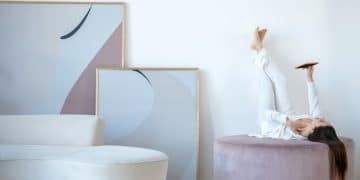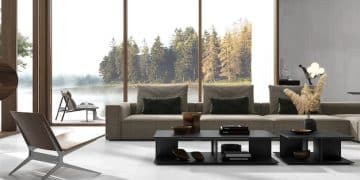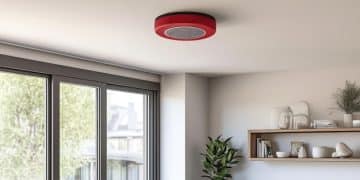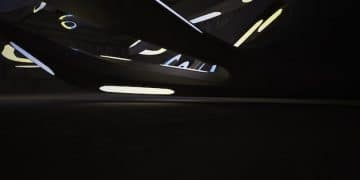Functional & Stylish Home Office: Decor Ideas for 2025
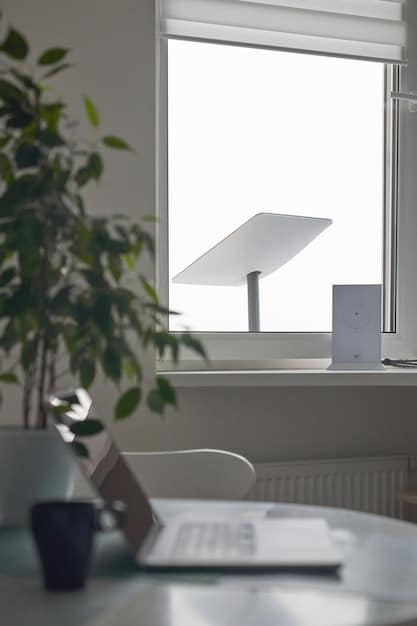
Anúncios
To create an ideal home office in 2025, focus on balancing aesthetics with functionality, integrating ergonomic solutions, smart technology, and personalized design elements that enhance productivity and well-being within a stylish and comfortable environment.
The concept of the home office has evolved from a temporary workaround to a fundamental pillar of modern professional life. As we step into 2025, creating a functional and stylish home office: decorating ideas for 2025 are no longer just about placing a desk and a chair; it’s about crafting a dedicated, inspiring, and highly efficient space that caters to individual needs, promotes well-being, and reflects personal style while maximizing productivity.
Designing for Ergonomics and Well-being
The foundation of any effective home office lies in its ergonomic design. Long hours spent at a desk can take a toll on physical health, making intentional furniture choices and layout crucial. Beyond just comfort, a well-designed ergonomic setup actively contributes to sustained productivity and reduces the risk of long-term injuries.
The Ergonomic Imperative
Investing in ergonomic equipment is not an extravagance; it’s a necessity for anyone spending significant time working from home. The right chair and desk form the core of this investment.
- Adjustable Desk: A standing desk allows for dynamic posture changes, reducing sedentary time and improving circulation. Options range from full electronic models to desktop converters.
- Ergonomic Chair: Look for chairs with lumbar support, adjustable armrests, seat depth, and height. High-quality chairs promote healthy spinal alignment and minimize strain.
- Monitor Height: Position your monitor at eye level to prevent neck strain. This often means using a monitor arm or stand.
Proper lighting also plays a critical role in well-being. Natural light is always preferable, but when unavailable, a combination of ambient, task, and accent lighting can create a balanced and comfortable visual environment, reducing eye strain and improving focus. Consider smart lighting solutions that adjust color temperature and brightness throughout the day.
A functional and stylish home office extends beyond just the main workstation. It incorporates elements that support overall well-being, such as biophilic design, which integrates natural elements like plants to enhance creativity and reduce stress. Thoughtful attention to these details ensures the office is a place of comfort and sustained output.
Integrating Smart Technology Seamlessly
In 2025, technology is no longer just a tool; it’s an integrated part of our environment. A truly functional home office embraces smart technology not for the sake of novelty, but to enhance efficiency, convenience, and connectivity. Seamless integration means these technologies should streamline workflows without cluttering the space or adding complexity.
From smart lighting systems that adapt to the time of day to voice-controlled assistants managing schedules, the possibilities are vast. The key is to select technologies that genuinely benefit your work style rather than merely adding gadgets.
Core Smart Office Technologies
While the market is flooded with smart devices, certain categories stand out for their ability to transform a home office experience.
- Smart Lighting: Systems like Philips Hue or Nanoleaf allow users to control brightness, color, and even warmth, adapting the lighting to different tasks or times of the day, which positively impacts mood and reduces eye strain.
- Smart Power Strips/Outlets: These devices enable remote control of power to your electronics, allowing you to turn off equipment not in use, saving energy, and reducing phantom draw.
- Noise-Canceling Technology: High-quality noise-canceling headphones are essential, but for shared spaces, consider acoustic panels or white noise machines to create a quieter, more focused environment.
Beyond these, look into smart assistants (speakers with Alexa or Google Assistant built-in) for quick queries, managing calendars, or controlling other smart devices hands-free. Integrating smart storage solutions can also help declutter, with automated drawers or shelving responding to voice commands. The aim is to create an intuitive workspace where technology serves as an invisible assistant, enhancing focus and efficiency rather than being a distraction.
Successfully integrating smart technology into a home office means choosing devices that are interoperable and serve a clear purpose in improving productivity or comfort. It’s about creating an intelligent ecosystem that supports your work style, minimizing manual adjustments and maximizing seamless interaction.
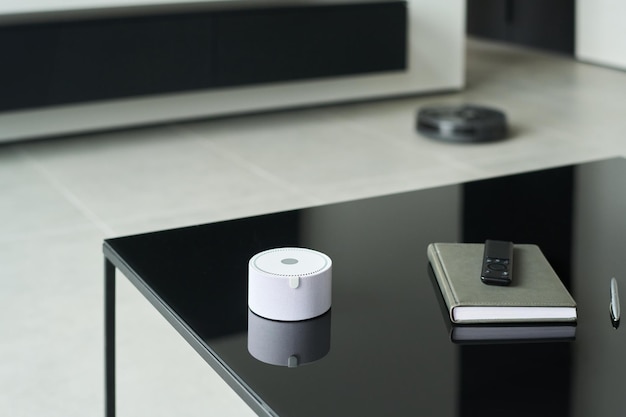
Optimizing Space and Layout for Productivity
Regardless of size, every home office has the potential to be a highly productive sanctuary. The key lies in strategic space optimization and a well-thought-out layout. This involves more than just fitting in furniture; it’s about creating flow, defining zones, and ensuring every inch serves a purpose.
For smaller spaces, vertical storage and multi-functional furniture become invaluable. A wall-mounted desk that folds away, or shelves that double as decorative displays, can transform a cramped corner into an efficient workstation. In larger rooms, delineation is crucial – perhaps using a rug or a discrete screen to separate the work area from the rest of the living space, signaling a mental shift into work mode.
Maximizing Every Square Foot
Even the most modest spaces can be transformed with clever design choices. The goal is to make the space work harder for you, ensuring every item has its rightful place and contributes to the office’s overall serenity and efficiency.
- Vertical Storage: Utilize walls with floating shelves, tall bookcases, or pegboards to keep surfaces clear and organized.
- Multi-functional Furniture: Consider ottoman storage, pull-out desks, or daybeds that convert into sofas, offering versatility without sacrificing space.
- Clutter Management: Implement a strict “a place for everything” policy. Use drawer organizers, file folders, and cable management solutions to minimize visual noise.
The layout should facilitate ease of movement and access to essential tools. Position your desk to take advantage of natural light, and consider the backdrop for video calls. A visually appealing and organized backdrop can enhance professionalism. Thoughtful cable management is also paramount, transforming tangled wires into an almost invisible network, contributing to a clean and distraction-free environment.
Ultimately, optimizing space and layout is about creating an environment that supports your focus and efficiency. It’s about designing a space that feels expansive and inviting, regardless of its actual footprint, fostering a clear mind and uninterrupted work flow.
Personalizing with Style: Beyond Function
While functionality is paramount, a home office should also be a reflection of your personal style, a place that inspires creativity and makes you genuinely enjoy spending time there. Moving beyond the purely pragmatic, personalization imbues the space with character and warmth, transforming it from a mere workstation into a true extension of yourself.
This is where decorating ideas for 2025 truly shine. Think about color palettes that stimulate or soothe, art that inspires, and textures that invite comfort. Avoid a sterile, corporate feel; instead, infuse the space with elements that resonate with your tastes and preferences. This balance between utility and aesthetics is what elevates a good home office to a great one.
Infusing Personality and Aesthetic Appeal
Personalization is about integrating elements that reflect your identity and make the space uniquely yours. It’s about creating an atmosphere that promotes comfort and motivation.
- Color Psychology: Research colors that align with your work. Cool tones (blues, greens) often promote calm and focus, while warmer tones (yellows, oranges) can stimulate creativity and energy.
- Art and Decor: Adorn your walls with art that speaks to you, whether it’s abstract pieces, landscapes, or personal photographs. Curated decor items, like interesting sculptures or decorative vases, add visual interest.
- Textural Elements: Incorporate soft furnishings like throws, cushions, and rugs to add warmth and absorb sound, creating a cozier, more acoustically pleasing environment.
Plants are another powerful tool for personalization, bringing life and natural beauty into the space. Their presence can improve air quality and reduce stress. Consider incorporating personal mementos or travel souvenirs that evoke positive memories. The goal is to craft an environment where every detail contributes to a harmonious and inspiring whole, making work feel less like a chore and more like an enjoyable pursuit.
A stylish home office is not just about looking good; it’s about feeling good. By thoughtfully incorporating personal touches and aesthetic elements, you create a space that not only supports your work but also nurtures your spirit, fostering a more enjoyable and productive experience.
Lighting and Ambiance: Setting the Mood
Effective lighting in a home office goes far beyond merely dispelling darkness. It meticulously shapes the ambiance, influences mood, and directly impacts productivity and eye comfort. In 2025, the approach to office lighting is strategic, combining natural light integration with sophisticated artificial light layering to create a dynamic and adaptable environment suitable for any task or time of day.
Think about the interplay of different light sources: ambient light for overall illumination, task lighting focused on specific work areas, and accent lighting to highlight decorative elements or architectural features. This multi-layered approach ensures versatility and prevents monotony, allowing you to tailor the light to your specific needs.
Strategic Illumination for Optimal Work
The right lighting choices can transform a functional space into an inspiring one, preventing digital eye strain and creating an environment conducive to sustained focus.
- Maximize Natural Light: Position your desk near a window if possible, but use blackout or sheer blinds to control glare throughout the day. Natural light is proven to boost mood and productivity.
- Layered Lighting: Combine an overhead fixture (ambient) with a good desk lamp (task) and perhaps a floor lamp or wall sconces (accent). This provides flexibility and depth.
- Color Temperature Control: Opt for smart bulbs that allow adjustment of color temperature from cool, stimulating daylight tones to warm, relaxing evening hues, aligning with your circadian rhythm.
Desk lamps should provide focused, glare-free light; consider models with adjustable arms and dimming features. For overall ambiance, incorporate fixtures that offer soft, indirect light, minimizing harsh shadows. The goal is to reduce eye strain, minimize reflections on your screen, and create an inviting atmosphere that encourages prolonged work without fatigue. Strategic placement of mirrors can also amplify natural light in smaller spaces, making them feel brighter and more expansive.
By consciously curating the lighting in your home office, you create not just a well-lit space, but one that actively supports your workflow and enhances your overall well-being, proving that effective illumination is truly foundational to a successful workspace.
Sustainable and Eco-Friendly Choices for 2025
As we advance into 2025, sustainability is no longer a niche concern but a driving force in design and consumer choices. For the home office, embracing eco-friendly practices means selecting materials, furniture, and technologies that minimize environmental impact, promote health, and contribute to a more responsible lifestyle. This approach extends beyond merely purchasing recycled items; it encompasses the entire lifecycle of a product, from sourcing to disposal.
Choosing sustainable means opting for durable pieces that stand the test of time, reducing the need for frequent replacements. It also involves prioritizing non-toxic materials that contribute to better indoor air quality, essential for a space where you spend many hours.
Making Conscientious Design Decisions
Building an eco-friendly home office involves thoughtful consideration of every element, ensuring your workspace aligns with broader environmental values without compromising on style or functionality.
- Recycled and Upcycled Furniture: Look for furniture made from recycled wood, metal, or plastic, or consider upcycling existing pieces with a fresh coat of low-VOC paint.
- Natural and Non-Toxic Materials: Prioritize natural fibers for textiles (organic cotton, linen, hemp) and non-toxic, low-VOC (Volatile Organic Compound) paints and finishes to improve indoor air quality.
- Energy Efficiency: Opt for energy-star certified electronics, use smart power strips to reduce phantom load, and rely on natural light as much as possible to cut down on electricity consumption.
Consider supporting local artisans and businesses that employ sustainable manufacturing practices. This not only reduces your carbon footprint but often results in unique, high-quality pieces. Incorporating indoor plants, beyond their aesthetic appeal, can naturally filter air, further enhancing the health of your workspace. Even small details, like using rechargeable batteries or printing less, contribute significantly to cultivating a truly green home office.
Ultimately, a sustainable home office is a testament to mindful living. It’s a space where every choice reflects a commitment to environmental responsibility, creating an inspiring and healthy environment that benefits both you and the planet.
Embracing Biophilic Design for Enhanced Productivity
Biophilic design, the integration of natural elements into built environments, is gaining significant traction in home office design for 2025. It’s based on the innate human connection to nature and has been shown to improve well-being, reduce stress, and even enhance cognitive function and creativity, all highly desirable traits for a productive workspace. Moving beyond just placing a potted plant, biophilic design involves a deeper, more intentional incorporation of natural patterns, materials, and vistas.
This approach transforms the sterile office into a vibrant, living ecosystem, fostering a sense of calm and clarity. It’s about designing a space that feels inherently good to be in, encouraging focus and sustained effort without feeling draining.
Bringing Nature Indoors, Strategically
Incorporating biophilic elements requires creativity and attention to detail. The goal is to create a harmonious environment that subtly reminds you of the natural world, even indoors.
- Living Plants: Beyond traditional desk plants, consider larger floor plants, vertical gardens, or even a small indoor water feature. Choose varieties that thrive indoors and are easy to maintain.
- Natural Materials: Opt for furniture and decor made from natural wood, stone, cork, or bamboo. These materials add texture and organic warmth to the space.
- Natural Patterns and Views: Incorporate patterns that mimic natural forms (e.g., wood grain, leaf motifs). If possible, orient your desk to have a view of outdoor greenery or a natural landscape.
Even if a direct view of nature isn’t possible, consider artwork that depicts natural scenes or textured wallpapers that evoke organic patterns. The use of natural light is a cornerstone of biophilic design; maximize it and consider sheer curtains to gently diffuse harsh sun. Introducing sounds of nature, even subtly through a sound machine, can further enhance the biophilic experience. The presence of these elements subtly reduces mental fatigue and supports a more tranquil and productive state of mind.
Embracing biophilic design in your home office is a powerful way to tap into the restorative power of nature. It’s about creating a workspace that not only supports your professional endeavors but also nurtures your intrinsic connection to the natural world, leading to a more harmonious and effective working experience.
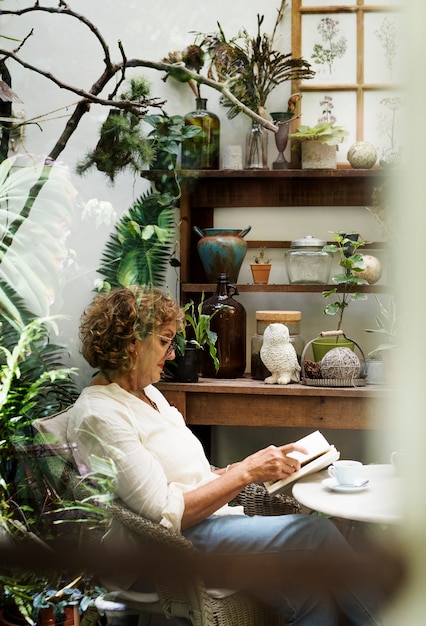
| Key Point | Brief Description |
|---|---|
| 🧘 Ergonomics First | Prioritize adjustable desks and ergonomic chairs to support long-term physical health and boost productivity. |
| 💡 Smart Tech Integration | Incorporate smart lighting, power solutions, and noise cancellation for enhanced efficiency and comfort. |
| 🌿 Biophilic Boost | Add natural elements like plants and natural materials to reduce stress and improve focus. |
| 🎨 Personal Style | Infuse personal aesthetics through color, art, and decor to create an inspiring and unique workspace. |
Frequently Asked Questions About Home Office Design
The most crucial ergonomic investments are an adjustable standing desk and a high-quality ergonomic chair. These two items form the foundation of a healthy workspace, promoting proper posture, reducing strain, and allowing for dynamic movement throughout the workday. Additionally, ensure your monitor is at eye level to prevent neck discomfort. These choices prevent long-term physical issues.
Focus on seamless integration and minimalism. Choose devices that serve multiple functions or are nearly invisible, like wireless chargers built into desks. Utilize smart power strips to manage cables and hidden smart speakers. Opt for integrated lighting systems. The goal is to have technology enhance your workflow subtly, without visual noise, maintaining a clean and organized aesthetic in your home office.
Maximizing space in a small home office involves strategic vertical storage, multi-functional furniture, and meticulous organization. Utilize wall-mounted shelves, floating desks, and tall bookcases. Consider an ottoman that offers both seating and storage. Implement drawer organizers and cable management systems to keep surfaces clear. Clever furniture arrangement can also define zones even in compact areas.
Biophilic design enhances productivity by reducing stress, improving focus, and boosting creativity. Integrating natural elements like plants, natural light, and organic textures creates a calming and inspiring environment. This connection to nature helps to reduce mental fatigue, improve mood, and contributes to better cognitive performance, making the workspace more enjoyable and conducive to sustained work.
Key considerations for lighting involve layering different types of light for versatility and comfort. Maximize natural light with strategic desk placement and blinds for glare control. Supplement with ambient, task, and accent lighting. Choose bulbs with adjustable color temperature to match time of day or work task. Proper lighting reduces eye strain, prevents fatigue, and sets an inviting and productive mood.
Conclusion
As remote work firmly establishes its place in the modern professional landscape, the home office transcends its role as a mere functional space. By integrating thoughtful ergonomics, smart technology, and deeply personalized design elements – all underpinned by a conscious choice for sustainability and the enriching influence of biophilic principles – we can transform these spaces into truly inspiring environments. A well-designed home office for 2025 isn’t just about efficiency; it’s about fostering a holistic sense of well-being that promotes long-term productivity and creative fulfillment. It’s a testament to how our physical surroundings can profoundly shape our professional lives, merging form and function to create a truly exceptional place to work.
